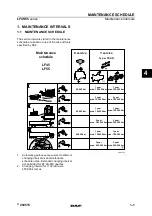
TRANSMISSIONS AND CLUTCHES 7B-l 1
SECTION 7B
TRANSMISSION ON-VEHICLE SERVICE OPERATIONS
This section contains service information on the following:
Subject
Page No.
Troubleshooting - Manual Transmissions...................................................
7B-11
Transmission Replacement - Manual Transmissions................................
7B- 14
Rear Oil Seal Replacement - Manual T r a n s m is s io n s ................................
7B-16
TROUBLESHOOTING-MANUAL TRANSMISSIONS
The following troubleshooting information will
assist in locating transmission troubles, but in ad
dition will serve as a guide to find the “ cause” to
prevent reoccurrence.
Whenever possible, road test the vehicle prior
to replacement or overhaul of the transmission.
Mechanics usually get second or third hand re
ports of trouble experienced with the unit and
these reports do not always accurately describe
the actual conditions. Sometimes symptoms seem
to indicate trouble in the transmission; while ac
tually the trouble may be caused by the axle, pro
peller shaft, universal joint, engine or clutch.
Therefore, before removing transmission or re
lated components to locate trouble, always road
test to check possibility that trouble may exist in
other closely associated units. If the mechanic
can drive, road testing will be more effective;
however, just riding with the driver can be very
informative.
If remote controls are used, a careful check
of the remote and connecting linkage to transmis
sion and auxiliary must be made. The remote
units and linkage must be in good working order if
the transmission and auxiliary are expected to
shift satisfactorily.
NOISY OPERATION
Noise is usually very elusive and generally
not the fault of the transmission; therefore, m e
chanics should road test to determine if the
driver’ s complaint of noise is actually in the
transmission.
NOISE ARISING O U TSIDE TRANSMISSION
In numerous instances, drivers have insisted
that the noise was in the transmission, however,
investigations revealed the noise to be caused by
one of the following conditions:
1. Fan out-of-balance or blades were bent.
2. Defective vibration damper.
3. Crankshaft out-of-balance.
4. Flywheel out-of-balance.
5. Flywheel mounting bolts loose.
6. Engine rough at idle producing rattle in
gear train.
7. Clutch assembly out-of-balance.
8. Engine mounts loose or broken.
9. Power take-off engaged.
10. Universal joints worn out.
11. Propeller shafts out-of-balance.
12. Universal joint angles out of phase or at
excessive angle.
13. Center bearings in drive line dry - not
mounted properly, etc.
14. Wheels out-of-balance.
15. Tire treads humming or vibrating at cer
tain speeds.
NOISE ARISING IN TRANSM ISSION
Mechanics should try to locate and eliminate
noise by means other than transmission removal,
or overhaul. However, if the noise appears to be
in the transmission try to break it down into the
following classifications. If possible determine
what position the gearshift lever is in when the
noise occurs. If the noise is evident in only one
gear position, the cause of the noise is generally
traceable to the gears in operation.
1. Growl and Humming, or more serious, a
grinding noise. These noises are caused by worn,
chipped, rough, or cracked gears. As gears con
tinue to wear, the grinding noise will be notice
able, particularly in the gear position that throws
the greatest load on the worn gear.
2. Hissing, or more serious a thumping or
bumping-type noise.
Hissing noises could be
CHEVROLET SERIES 70 -80 H EAVY DUTY TRUCK SH O P M A N U A L
Summary of Contents for 70 1969 Series
Page 1: ...CHEVROLET HEAVY DUTY TRUCK SHOP MANUAL...
Page 3: ......
Page 11: ...LUBRICATION 0 4 CHEVROLET SERIES 70 80 HEAVY DUTY TRUCK SHOP MANUAL...
Page 27: ......
Page 119: ......
Page 361: ......
Page 371: ......
Page 427: ......
Page 443: ......
Page 451: ......
Page 493: ......
Page 499: ......
Page 549: ......
Page 555: ......
Page 609: ......
Page 715: ...am...
Page 745: ......
Page 910: ......
Page 913: ......





































